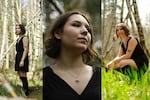This story originally appeared on Underscore Native News.
Editor’s note: This story is the latest installment in our Youth Profiles series. You can read past stories in the series here, and stay tuned for more in the future.

Kazsia Connelly, 18, is an aspiring actress and screenwriter from the Confederated Tribes of Grand Ronde. She posed for her portrait in the forest near her apartment on the Grand Ronde Reservation on March 26, 2025.
Jarrette Werk / Underscore Native News
Trekking through the woods by her apartment in late March, Kazsia Connelly reminisced about making a zombie short film a few years prior, using this very forest as a backdrop for the movie, which a classmate wrote and directed and Connelly starred in for a media production class in high school.
Connelly, 18, grew up in Willamina, Oregon, a small town of under 2,500, just minutes down the road from Grand Ronde. In January, she started at Southern Oregon University in Ashland and plans to pursue a degree in digital cinema. Passionate about film and Indigenous representation, Connelly hopes that the characters she plans to play on screen and the short films she dreams of writing will be able to help break down stereotypes and inspire other young Indigenous kids.
Crawling over fallen branches and avoiding the stinging nettle plants littering the ground of the mossy forest, Connelly, a citizen of the Confederated Tribes of Grand Ronde, reflected on her dreams of becoming an actress.
“Especially as an Indigenous person, I was scared at first,” Connelly said, describing the toxicity she hears of in Hollywood. “I want to change the film industry.”

Kazsia Connelly, 18, wrote her first script when she was a junior in high school. She is now wrapping up her first semester at Southern Oregon University, where she plans to major in digital cinema.
Jarrette Werk / Underscore Native News
Her dream role would be to play Korra, the main character in the animated series “The Legend of Korra,” a spinoff from the popular show “Avatar: The Last Airbender.”
In 2024, Netflix released a live-action version of “Avatar: The Last Airbender.” Connelly loved the series and felt particularly inspired by the Indigenous woman who played the character Katara, a young Mohawk actress named Kiawentiio.
“One of the main reasons why I’m an actor is because I’m an Indigenous woman, and there’s not lots of Indigenous people in films or TV shows or media in general,” Connelly said. “I remember when I was a kid, whenever I saw a person of color [on screen], I was like, ‘That’s so cool. That’s me.’”
Reconnecting with culture
Connelly remembers many summers spent at the annual powwow in Grand Ronde. But, although she lived close, she describes herself as growing up a bit disconnected from culture, and is seeking to rekindle that connection now.
“I wasn’t raised in my culture,” Connelly said. “Now that I am a young adult, I don’t want my kids to be raised separated from culture. Reconnecting with my culture has just been a relief and made me at peace.”
Connelly graduated from Willamina High School last year and moved to Grand Ronde in December. She now splits her time between her apartment in Grand Ronde and the dorms at Southern Oregon University in Ashland.
Connelly describes a mixed experience in the Willamina School District, including seeing a lot of racism and sexism in school.

Through her acting and filmmaking, Kazsia Connelly hopes to break stereotypes, inspire young Indigenous kids and contribute to more on-screen representation.
Jarrette Werk / Underscore Native News
By high school, she began to develop her voice as an advocate for women and Indigenous people. Now, that means tapping into her creative voice through poetry and the characters she hopes to both portray and write.
“[Indigenous people], we’re powerful. We have gone through so much throughout decades and hundreds of thousands of years,” Connelly said. “And we are still here. And that is saying so much.”
Dreams of acting
Connelly first developed an interest in acting in middle school.
“In eighth grade, I took drama class and I just fell in love with acting,” Connelly said, remembering being in her first play that year called “The Wedding.”
The next year, she attended Willamina High School, which has an enrollment of about 300. As a freshman, Connelly took a media production class with Ryan Lewis, the school’s performing arts director. She continued to take his classes all throughout high school, acting in a few short films.
In her junior year media production class, the students were assigned basic script writing, but Connelly went above and beyond. She wrote, produced and starred in a 25-minute film titled “Maryona Spirit of Wildwood.”
In the film, Connelly plays the spirit of a young woman named Maryona who has come back to haunt the Wildwood hotel, where she died.
“She took on a leadership role in that she wrote out a script and she proposed the idea of shooting a film that she wrote,” Lewis said. “I respect her work ethic and her follow through because she does not fail to deliver. And that’s fairly uncommon with a kid that age.”

Taylor Brooks, left, and Kazsia Connelly, right, told Underscore Native News that their love story began when they were children. “We actually dated for an hour in elementary school,” Connelly said. “And then she broke up with me,” Brooks chuckled. Now the two have been dating for a year and a half.
Jarrette Werk / Underscore Native News
That year, the entire class ended up working on the film together. Connelly helped organize a bake sale at the local Wildwood hotel and the class raised $800 in one day to go toward production costs, according to Lewis.
The class spent many weeks working on the film, shooting at multiple locations, including the Grand Ronde Tribal Police Station, the Wildwood Hotel and a local pond.
“Going into it, we didn’t really know what to expect,” said Taylor Brooks, who starred in the film and is now Connelly’s boyfriend. “It turned from this mini project into something special that really brought the whole class together.”
As Connelly pursues her dreams of being both behind the camera and on screen, she also hopes to continue to dedicate attention to other creative outlets.
Connelly is a drummer and Brooks is also a musician, primarily playing electric bass. They hope to one day play in a band together. Connelly is also a writer, using poetry as a space to help process her emotions.
In her first term at Southern Oregon University, Connelly has already begun to dive into theater classes with an introduction to acting class, a script analysis class and a carpentry class.
As she thinks about her future career, both behind the scenes and on screen, she is determined to create films that portray strong, Indigenous women characters.
Underscore Native News is a nonprofit investigative newsroom committed to Indigenous-centered reporting in the Pacific Northwest. We are supported by foundations and donor contributions. Follow Underscore on Facebook, X, Instagram and TikTok.
This republished story is part of OPB’s broader effort to ensure that everyone in our region has access to quality journalism that informs, entertains and enriches their lives. To learn more, visit opb.org/partnerships.